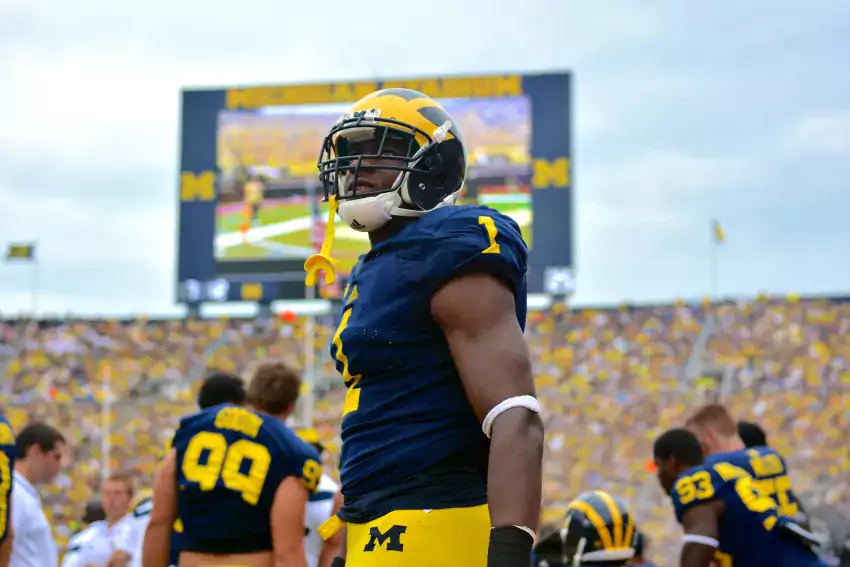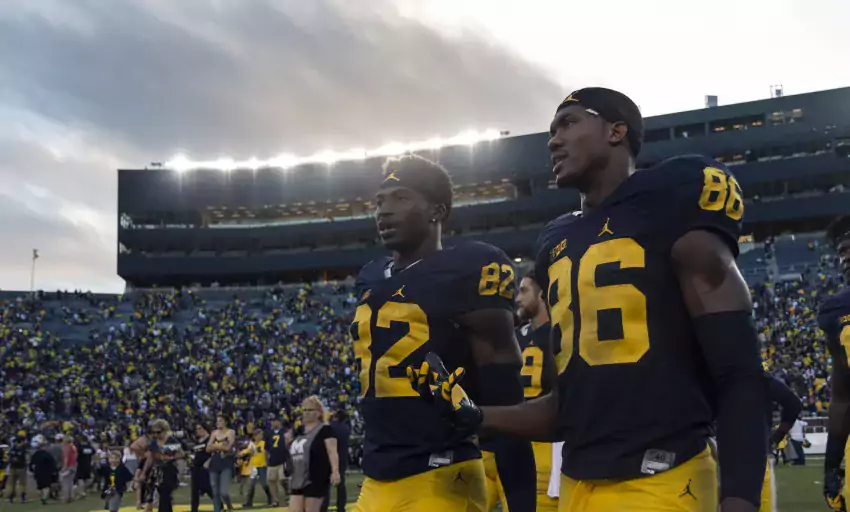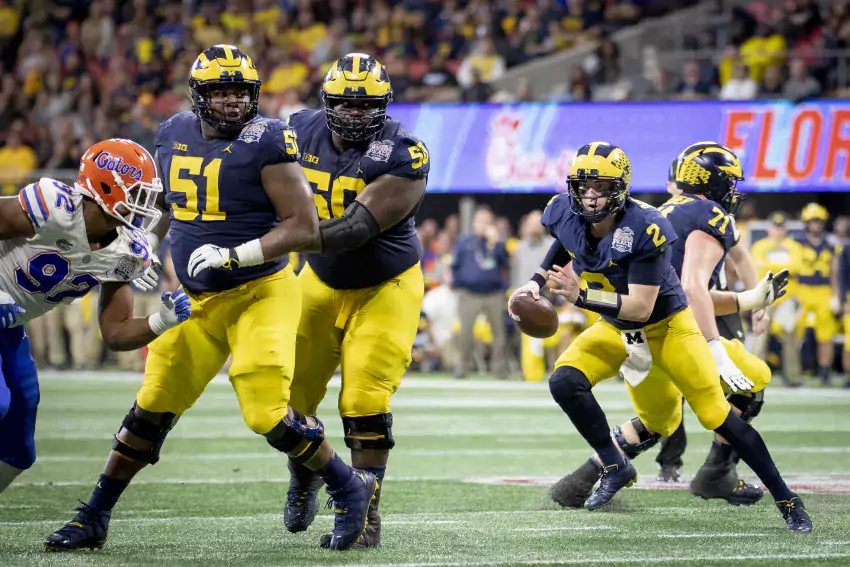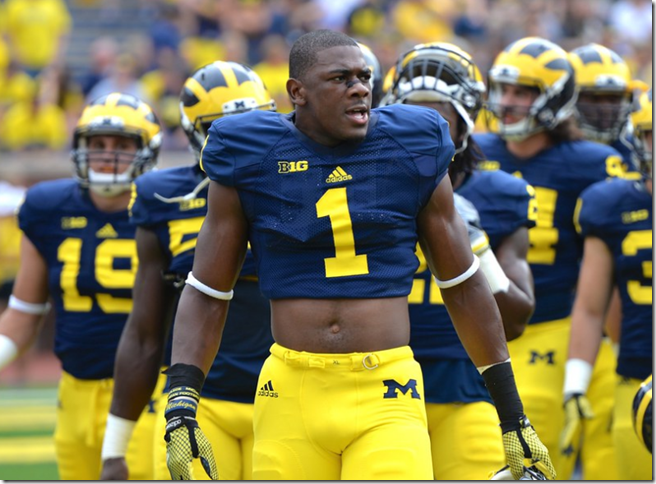devin funchess giant wide receiver activated

HTTV Note: The books are done and we're going to have copies in hand by the end of the week. If you backed the kickstarter and want to skip waiting for the mail (which is going to take longer than usual this year), we have socially distanced pickup options at Cultivate in Ypsilanti this Saturday, at Five Shores Brewing in Beulah next Saturday, and after I drive a few boxes out there, at Bryan Fuller's wife's Cheese Lady franchise in Kalamazoo. If you want to get your books there email me and let me know. If your address has changed email me and let me know.
--------
Are we starting to get desperate for content? Sure. But also I noticed we talk a lot about 3-stars versus 5-stars, when Michigan's classes have historically been filled primarily with standard 4-stars. And by that I mean "just" 4-stars—not top-150 players, and not high 3-stars either. They're the kind of players who would headline a Michigan State class, whom Ohio State would take but not fight too hard for, the constant subjects of Notre Dame-Michigan-Penn State battles with a hometown favorite thrown in.
Previously: Pro Offense/Pro Defense, 1879-Before Bo, 5-Stars, 3-Stars, Extracurriculars, Position-Switchers, Highlights, Numbers Offense/Numbers Defense, In-State, Names, Small Guys, Big Guys, Freshmen
Rules: Lower bound: must be a four-star to at least one major ranker of his era, and average over 4.0 stars on the Seth scale. Upper bound: cannot be ranked top-100 by anybody or higher than a 4.3 on the Seth scale. Since 1990 because data go back that far. College performance considered only.
The Mike Hart Thing: Hart was the equivalent of a solid four-star to places that didn't create a lasting online database of the 2004 class, and a high 3-star to Rivals and Scout, who did, forever after immortalizing him as a "3-star" (this is a well-known malfunction of the human brain). Just giving you fair warning that your brain is going to rebel. Also "bucket list" wasn't in the lexicon until the 2007 film.
Quarterback: Tom Brady (1995)
Rankings:
| Nat Rec Advisor | Lemming | BlueChip Illustrated | Superprep | ☆s | Rkg |
|---|---|---|---|---|---|
| 5.7 (#10 PRO) | #6 PRO, #26 West (AA) | #6 QB West, All American | #65 Far West | 3.84 | #27 QB |
(Ranking is among Michigan recruits at his position, which has a sample roughly as large as an annual national class so I've included it. National Recruiting Advisor was proto-Rivals.)
This seems like an obvious answer but Brady really only narrowly won a competitive three-way competition with longtime starters who preceded him and proceeded him. That's a good summary of Tom Brady's Michigan career, which has been poured over by so many better journalists there's not a lot I can add to it.
The just-a-four-star rating is also representative of his recruitment. Brady had a few top schools after him as a #2 option behind some monster 5-star or close to it. He might have gone to USC if they didn't get their first two guys on the board, and Cade McNown committing to UCLA removed Michigan's main competition. Michigan waited until Florida won the battle for 5-star Bobby Sablehaus then pulled the trigger on Tom.
2nd Team: Todd Collins (1990)
The only data point I have on Todd is he was Tom Lemming's #8 Pro-Style QB. Well that and pick two guys out of these three:
| Player | Att | Comp | TD | Int | Cp% | Yds | Lng | YPA | Rtg |
|---|---|---|---|---|---|---|---|---|---|
| Player A | 1366 | 765 | 72 | 31 | 56% | 9254 | 77 | 6.77 | 125.8 |
| Player B | 711 | 443 | 35 | 19 | 62% | 5351 | 76 | 7.53 | 136.4 |
| Player C | 711 | 457 | 37 | 20 | 64% | 5858 | 90 | 8.24 | 145.0 |
Player B is Tom Brady. The guy with nearly identical college stats and vastly higher yards per attempt is the longtime starter who also had an extremely long NFL career. You also have to know that the two years of Collins starting were even more frustrating offensively than the Borges and DeBord offenses, and the Number 1 frustration was they weren't uncorking the passing game. Amani Toomer and Mecury Hayes were the Nico Collins and Ronnie Bell of the era, except when Michigan did deign to send them a pass Collins almost always put it on the money. Watching the semi-heralded Collins outperform Notre Dame golden boy Ron Powlus was one of the highlights of my young fandom.
The Field: Collins (4.24, 199), Scot Loeffler (4.20, 1993), Cade McNamara (4.12, 2019), Joe Milton (4.11, 2018), Nate Holdren (4.07, 1990), Alex Malzone (4.06, 2015), Spencer Brinton (4.05, 2001), John Navarre, who's Player A above (4.04, 1999)
[After THE JUMP: Guys who were dudes]

Previously: 2008 Offense, 2008 Defense, 2009 Defense, 2009 Quarterbacks, 2009 Offense, 2010 Offense, 2010 Defense, 2011 Offense, 2011 Defense
This used to be a thing on MGoBlog, until the 2011 class depressed Ace so badly that he gave up afterwards. Someone would have to be extremely desperate for content to dig this up and get caught up. Or just incredibly brave. And stupid. Probably all.
This was Brady Hoke's first real class, since he only had a few weeks in 2011 to tack on a few fliers to whatever had stuck around. The unicorn poop run of 2011 fueled belief that the goofy guy might actually be more clever than he let on, while the Tressel scandal in Columbus removed an important piece from the board. This was Hoke's opportunity to strike, and strike he did, building the core of what would become a senior-laden, ill-fated run at the championship in 2016. While Hoke was always better on defense, this was actually a pretty well-scouted as well as well-starred class, give or take a couple of tight ends who should have been something else.
Quick Glossary
YMRMFSPA: "You might remember me from such players as." The shorthand we use in recruiting profiles to say what type of player a guy would be if he works out.
404 Quarterback Not Found
Aaand he forgot the most important position. With Shane Morris committed for 2013 and Russell Bellomy, a late flip from Purdue, the only quarterback taken in 2011, this looked like quite the oversight at the time. I'm sure it wouldn't come back to haunt them.
The Greatest Receiving Recruiting Class Since…?
Move over, Terrell and Walker, because once you include the receiver they expected to be a tight end and the receiver they expected to be a running back, this class gave Michigan 5,573 yards and 41 touchdowns through the air (compare to the 1998 class's 4,586 yards and 40 TDs). The two African refugees, Amara Darboh (YMRMFSPA "Aw, hell, Jason Avant") and Jehu Chesson (Adrian Arrington), were cause to invoke the Legends of '98. Chesson's responses to reporters were wise beyond Craig Ross's years, Darboh got knocked for his speed in a coach quote now engraved on the FAKE 40 Times Trophy:
"He runs 4.42 but I wouldn't say that he's a burner by any stretch of the imagination," said Wilson. "He's a reliable guy that can make the tough catches for you. … he's a bigger physical presence. He's not a make you miss kinda guy."
Darboh's whole profile was like that: burly guy who's good with the ball in open space. This turned out to be a version of Avant who's really effective on smoke screens. Both stuck around into the Harbaugh era—Chesson because he arrived rail thin and redshirted, Darboh because an injury required a medshirt in 2013. Both peaked in 2015 and eschewed possible NFL opportunities for good but relatively disappointing (ungh, those drops in Iowa) senior runs. Darboh went in the 3rd round and remains with the Seahawks. Chesson, who's still pretty skinny, was drafted in the 4th round by the Chiefs and is lately hanging around on the margins of the league.
[Bryan Fuller]
Devin Funchess ("A less existentially depressed Jake Stoneburner, or Kevin Koger") was part of a four-man group of Farmington Hills Harrison (RIP) players to go Big Ten, and not even the highest-ranked receiver from his high school class. That was Aaron Burbridge, whom Michigan gave up on getting eligible for college and Michigan State somehow managed to get into school after a year of remedial stuff. Funchess was supposed to bulk up to tight end, whereupon he'd become what we want Eubanks to be this year. This wasn't as far-fetched as it appears in retrospect. The Michigan coaches thought Devin could bulk up to 240, he came in officially at 229, and his three-star profile certainly didn't give off an air of a three-and-done 1st round WR. Given zero depth at tight end, a redshirt seemed unlikely. Like his refugee classmates, the general excitement level was "High," with the suggestion he could challenge Mandich's all-time TE receiving yardage record. Because SIDs don't generally alter positions mid-season, this came to pass.
By October 2013, we had the "devin funchess wide receiver possibility" tag in existence, and soon after it was just the reality. In 2014 he switched from his tight end legends number to #1, spent most of that seasons either hurt or hurt enough not to play, and was drafted in the 2nd round. At his best he was hurdling Buckeyes and uncoverable by most cornerbacks for reasons just as apparent when we talk about Nico Collins today. After four years and 2,233 yards with Carolina he signed a one-year contract this year with the Colts.
The last receiver was the last guy added to the class. I was texting or gchatting or something with Brian as signing day was winding down and we were both complaining that jitterbug Dennis Norfleet wasn't offered. Then Michigan struck out on all of the top-end guys they were in on, added a DT, and finally Norfleet. Thus began a long battle between MGoBlog and Hoke's staff about using Norfleet as anything but the most obvious jet sweep target or dancing returner, whereat he got no TDs but set a record that will never be touched in TDs bogusly called back. By Hoke's end Norfleet was trying at cornerback and getting into academic issues that ultimately ended his career a year early.
[After THE JUMP: Who's going to block for a generation?]

We did the little people. Now it's time to find the best and the biggest.
Previously: Pro Offense/Pro Defense, 1879-Before Bo, 5-Stars, 3-Stars, Extracurriculars, Position-Switchers, Highlights, Numbers Offense/Numbers Defense, In-State, Names, Small Guys
Rules: Just like the all-small roster, a player gets equal points for being large and for being excellent. Here however I will count weight on equal footing with height, since most of these guys weren't trying to shed it. This one is going to favor more modern players; Germany Schulz was considered a huge center for his time at 6'2/212 and until the 1980s even the linemen who were over 300 pretended not to be. So there's an all-relative team hanging out in here too.
-----------------------------------------
Quarterback: John Navarre, 6'6"/228 (2003)
What's an arc?
My top quartile rule plus the Age of the Howitzer puts us in the weird position of disqualifying 6'5" Tom Brady, Todd Collins, and Jim Harbaugh, sticking us with a pool of Speight, Mallett, Cone, Kapsner, Sessa, Ziegler, and LURRRRRRCH! The stuff about the campus not being very much behind Tom Brady is so much stuff because the same people were on campus for much or all of Navarre and there's no question who was pined for and who maligned.
Much of that is because underclassman Navarre had to play the bulk of the time we'd carved out for Henson. Navarre broke in as a redshirt freshman when Henson got hurt in early 2000, terrorized a pair of MAC teams, then was awful against UCLA. With Henson off to baseball in 2001, Navarre leaned heavily on Marquise Walker and the offense was, well, Lurch-y. By 2002 he had his feet under him and in 2003, with Braylon and Avant, Michigan got an excellent and high-volume passing season out of the big guy, setting all the passing records and more importantly leading Michigan to a win over defending national champion Ohio State and a trip to the Rose Bowl.
Relatively: Bob Timberlake (6'4/211) was a modern-sized quarterback right at the beginning of the pocket QB era. Forest Evashevski (6'1/198) was huge for the early 1940s.
Honorable Mention: Wilton Speight (6'6"/240)
-----------------------------------------
Running Back: Anthony Thomas (6'2/221)
Note: I have requested that WH change the music. If you mute the above and play the other it lines up well, especially at the bridge when that tom comes in while he's setting up a bunch of Hawkeyes and when Marquise Walker jumps on him.
The roster data have all kinds of lies to add to Bo and his successors' preference for big backs. Picking from a pile of guys who were listed at 6'2/220 and were actually more like 6'0 is virtually naming Michigan's best non-squib back. Some guys we knew were fullback-sized (Askew, Bunch) became fullbacks in the latter part of their careers. So let's not overthink this and go with the full-time running back whose NFL measurement agreed with his roster height, and who was literally referred to in his day in terms of a multi-ton vehicle, IE A-Train.
The size was definitely an issue…for opponents. A-Train had that patented three-yard fall that made his carries +EV even when the line didn't block well, and the added length made him one of Michigan's best pass-blocking running backs in memory.
Relatively: Jim Detwiler (6'3/209) is a mostly forgotten star from the mid-'60s who towered over the other RBs. Crazylegs Hirsch (6'2/190) was such a tall running back he went on to be the first great NFL wide receiver.
HM: Ty Isaac (6'3/228), Wyatt Shallman (6'3/239), Roosevelt Smith (6'3/232), B.J. Askew (6'3/210), Chris Perry (6'0"/228), Tyrone Wheatley (6'0/226), Jarrod Bunch (6'2/240)
[After THE JUMP: Poor Anthony Morelli]

They weren't always at these positions, but they're in these positions now in our hearts or something.

13